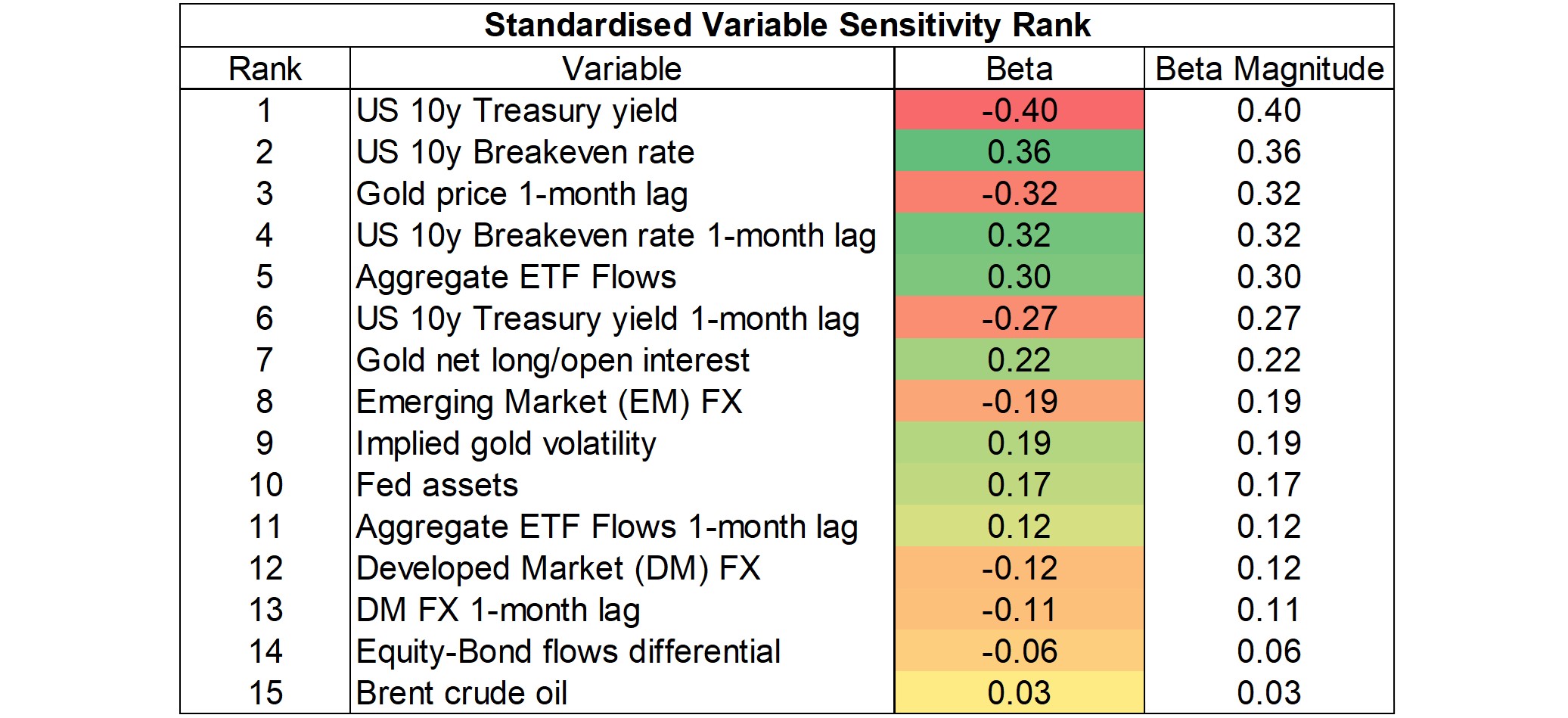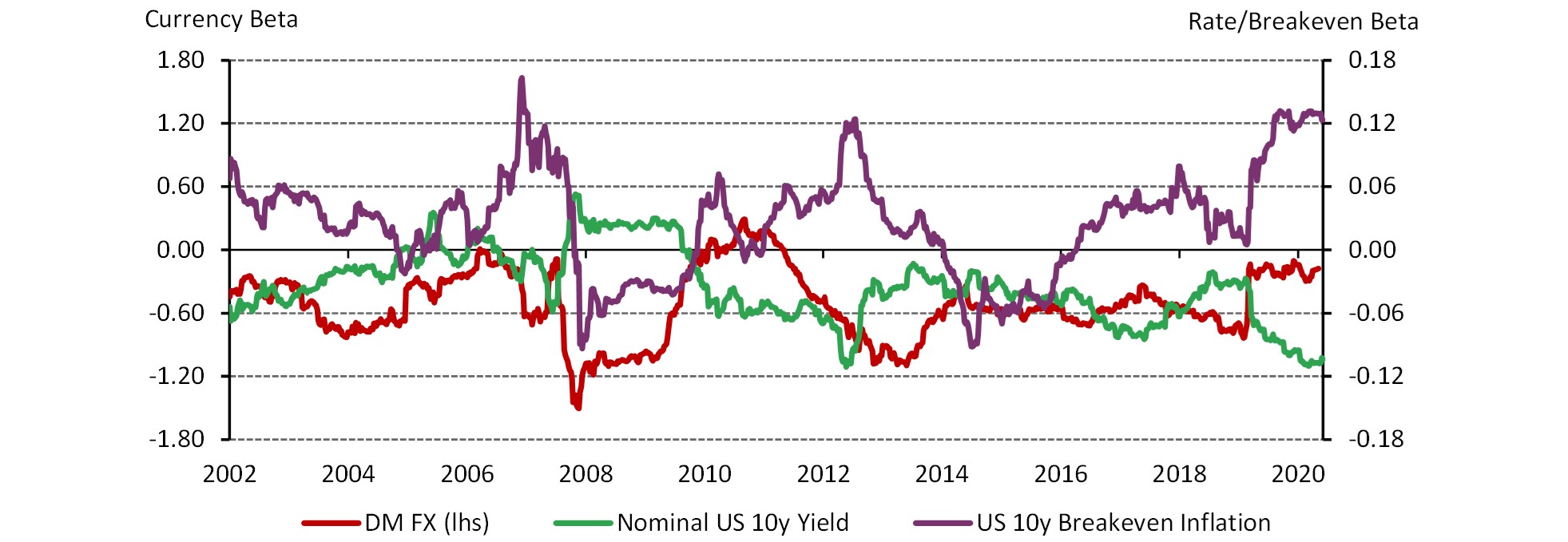- Our short-term gold performance model enables investors to dissect monthly gold returns into key drivers of investment demand
- Different estimation windows provide additional insights on the varying influence of drivers over time
- During May, our model shows gold’s performance was only modestly impacted by rates but they still remain a relevant driver this year
Previously we highlighted a key insight from our short-term gold model that there was increased sensitivity to certain variables, such as interest rates, which was driving prices lower at the time. With rates remaining steady last month alongside gold’s robust rally of more than 7%,1 investors may now be asking what other factors were influencing prices.
To answer this, we look again to our short-term gold performance model2 to help analyse monthly or intra-month gold returns using drivers of investment demand over the short term, which complements our longer-term Gold Valuation Framework (GVF).3
But what is our short-term model and how can investors use it?
Our model uses monthly inputs for multiple variables that can be grouped within four key drivers of gold performance,4 employing statistics from 2007 onwards. Using multiple regression, we calculate sensitivities for each variable and the contribution they make to each month’s gold return. We normalise each variable by its respective Z-score every month, or the difference from its overall mean divided by standard deviation, which allows us to gauge the impact of variables on gold in a standardised measure.
The model uses the full 14-year period as its starting point,5 but we can also use the model to estimate the coefficients over shorter windows (for example, two or three years) to assess how these change over time. We can further enhance this shorter window analysis by using weekly inputs to attribute intra-month performance and examine sensitivity over the past year.6
The combination of these different methodologies can help assess which quantitative variables better explain gold’s performance. Additionally, the result can be complemented by a qualitative assessment and anecdotal evidence to create a comprehensive picture of gold’s behaviour over time.
Using May 2021 as a practical example…
Gold increased 7.5% m-o-m in May, closing near to US$1,900/oz.7 Our model indicates that almost 4% came from momentum, driven by positive flows into gold ETFs as well as an increase in futures net long positions. This was more than double the contribution made by the oft-discussed opportunity cost driver, which captures both currencies and interest rates.
While momentum in gold positioning and funds may have outperformed other drivers last month, on average this does not hold up over the full 14-year estimation period. Table 1 shows that movements in interest rates and inflation expectations, as expressed by the US 10-year breakeven inflation rate, have had the largest absolute impact on gold returns since 2007, while the variable tied to developed market (DM) currencies, for example, has proven less consequential over the long-term horizon.
Table 1: Interest rate and inflation measures have led individual gold drivers since 2007
Coefficients of explanatory gold variables ranked by magnitude*
*As of 31 May 2021. Calculated by regressing monthly Z-scores of gold returns to monthly Z-scores of all variables from February 2007 to May 2021. Magnitude is measured by the absolute value of each variable’s regression beta. Note: DM FX comprises euro and yen dollar pairs. EM FX comprises Chinese yuan and Australian dollar pairs as a commodity currency. The equity-bond flows differential captures investor risk sentiment; higher risk tolerance sees flows to equities and vice versa.
Source: Bloomberg, World Gold Council
However, gold’s price sensitivities to different variables can change based on the estimation window. Looking at just the last three years, using monthly inputs, we see that gold’s sensitivity to DM currencies increased nearly four-fold over the last three years compared to the full period since 2007, while its sensitivity to the breakeven inflation rate increased by nearly three-fold. On the other hand, the influence of the prior month’s gold return in explaining current month performance reduced dramatically, as in recent years gold has not shown the mean-reverting characteristic that it has exhibited historically (Table 2). The weekly model also shows that in the past year gold’s sensitivity to interest rates rose three-fold compared to the full period, on top of similar recent trends of heightened sensitivity to DM currencies and breakeven inflation rates as well as a reversal in the impact of prior gold returns (Table 3). Lastly, both models show that in recent years gold prices have moved positively when flows into equity funds outweighed flows into bond funds, which generally occurs when investors maintain higher risk tolerance in the market. This highlights the fact that gold does not rally exclusively during market downturns, but rather can exhibit growth in both risk-on and risk-off environments as indicated recently.
Table 2: The last three years have seen a jump in gold’s sensitivity to DM currencies and inflation expectations
Full period vs trailing 3-year variable coefficients based on monthly returns, in %*
*Full period reflects data from February 2007 to May 2021. Recent period reflects trailing 3-year data from May 2018 to May 2021. The economic expansion driver is expressed as a constant in the model. Variables with positive correlation to gold in the full period are shaded in green and variables with negative correlation to gold in the full period are shaded in red. Note: DM FX comprises euro and yen dollar pairs. EM FX comprises Chinese yuan and Australian dollar pairs as a commodity currency. The equity-bond flows differential captures investor risk sentiment; higher risk tolerance sees flows to equities and vice versa.
Source: Bloomberg, World Gold Council
Table 3: In the preceding 52 weeks interest rates have also had an outsized impact on gold
Full period vs trailing 1-year variable coefficients based on weekly returns, in %*
*Full period reflects data from 5 January 2007 to 28 May 2021. Recent period reflects trailing 1-year data from 5 June 2020 to 28 May 2021. The economic expansion driver is expressed as a constant in the model. Variables with positive correlation to gold in the full period are shaded in green and variables with negative correlation to gold in the full period are shaded in red. Statistically insignificant lag variables are omitted from weekly analysis. Note: DM FX comprises euro and yen dollar pairs. EM FX comprises Chinese yuan and Australian dollar pairs as a commodity currency. The equity-bond flows differential captures investor risk sentiment; higher risk tolerance sees flows to equities and vice versa.
Source: Bloomberg, World Gold Council
Finally, looking at the rolling window over time provides additional detail, particularly in variables whose coefficients change markedly in the shorter time horizon compared to the full period. For example, gold’s sensitivity to changes in interest rates appears to be higher when its sensitivity to inflation expectations is also higher, including at present (based on weekly returns over the last two years). Meanwhile, throughout almost the entire period since 2007, DM currencies have shown a negative relationship to gold prices (Chart 1). This speaks to the opportunity cost of holding gold, and the fact that gold’s sensitivity to rates tends to rise when the market is paying more attention to what central banks are doing, and this is often the case when inflation is uppermost in investors’ minds.
Chart 1: Gold’s sensitivity to interest rates and breakeven inflation is near record highs
Trailing 2-year gold betas*
*Based on weekly returns from 1 December 2002 to 28 May 2021.
Note: DM FX comprises euro and yen dollar pairs. Based on LBMA Gold Price PM USD, Bloomberg US Government Generic 10-year Yield Index, and US 10-year Breakeven Inflation Index.
Source: Bloomberg, World Gold Council
Why this matters
The short-term gold performance model serves to provide insight into understanding gold returns over weeks and months, and it has been especially helpful recently as the dynamics of certain drivers have altered significantly. Moreover, adding iterations to the short-term model, such as shorter lookback windows, allows us to include detail that helps to explain gold’s performance in the current environment where the full period versions may be less perceptive. Furthermore, the model complements insights investors can draw from our Gold Valuation Framework. Utilising a combination of short-term models, with varying and sometimes rolling analysis periods, helps to minimise the extent of unattributed returns, and ultimately provides a clearer picture for investors on gold’s performance…even when prices swing.
Footnotes
Based on the LBMA Gold Price PM in USD as of 31 May 2021.
For more information please see Short-Term Gold Price Drivers | What Affects Gold Prices | Goldhub.
The Gold Valuation Framework (GVF) provides annual forecasts for gold performance in various macroeconomic scenarios based on the intersection of supply and demand. For more information please see Qaurum | A Valuation Model for Gold Relative to Macroeconomic Scenarios.
The four broad sets of drivers of gold performance are Economic expansion, Risk and uncertainty, Opportunity cost, and Momentum. For more information please see Gold Outlook 2021 | Gold Market Outlook | World Gold Council.
Model calculations start from 2007 due to data availability. Equity and bond flows data is not available until January 2007
The weekly short-term model is not currently available on Goldhub but we expect it to be added over the coming months.
Based on the LBMA Gold Price PM in USD as of 31 May 2021




